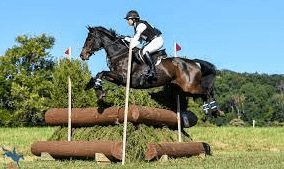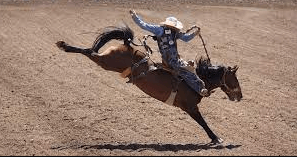What Are The Rules Of Eventing?

Eventing is a thrilling equestrian sport that combines three distinct disciplines: dressage, cross-country, and show jumping. Governed by a set of rules and regulations, eventing requires both horse and rider to showcase their skills in each of these areas.
This article aims to provide an informative overview of the rules of eventing, shedding light on the eligibility requirements for horses, as well as the specific criteria for dressage tests, cross-country courses, and show jumping courses.
In order to participate in eventing competitions, horses must meet certain eligibility criteria. They must be at least four years old and have a valid passport issued by the relevant national federation. Additionally, horses are required to be sound and fit for competition, ensuring their physical well-being throughout the demanding nature of eventing. Riders also play a crucial role in ensuring horse welfare during events by adhering to strict guidelines regarding equipment usage and horse management practices.
Moving on to dressage tests, this discipline focuses on precision and harmony between horse and rider. The tests consist of a series of predetermined movements performed within a designated arena. Judges evaluate each movement based on its accuracy, suppleness, rhythm, and overall presentation. Dressage not only showcases the technical abilities of both horse and rider but also sets the foundation for success in the subsequent phases of eventing. By demonstrating control over basic maneuvers such as circles, transitions between gaits, and changes in direction or speed, competitors establish their partnership with their equine counterparts before embarking on more challenging aspects of the sport.
Overall, eventing offers equestrians an exhilarating experience that demands proficiency in various disciplines while maintaining utmost respect for equine welfare. The rules governing eligibility requirements ensure fair competition among participants while prioritizing safety standards for both human athletes and their noble steeds.
Read also: Can Beginners Participate In Pole Bending Events, Or Is It Primarily A Sport For Experienced Riders?
While dressage emphasizes finesse and precision, the cross-country phase showcases courage, stamina, and strategic decision-making. Similarly, the show jumping component tests agility and precision as horse and rider navigate a series of colorful obstacles within a confined arena.
By examining the rules of eventing in detail, we can gain a comprehensive understanding of this exciting equestrian sport that captivates both participants and spectators alike.
Horse Eligibility and Requirements
Horse eligibility and requirements in eventing are governed by specific regulations that ensure fair competition and prioritize the welfare of the horses involved.
In order to compete in eventing, horses must be registered with the appropriate national governing body, which ensures that they meet certain standards for breed, age, and health.
Additionally, riders must also meet certain qualifications in order to participate in eventing competitions. These qualifications may include a minimum age requirement, a specified level of riding experience or training, and sometimes even specific certifications or licenses.
These eligibility criteria help maintain the integrity of the sport and ensure that both horse and rider are adequately prepared for the challenges of eventing.
Dressage Tests
Dressage tests in eventing consist of predetermined movements that showcase the horse’s training and athleticism.
These movements are performed in a designated arena, which is typically marked with letters to help guide the rider.
The tests are designed to assess the horse’s obedience, suppleness, and overall harmony with the rider.
Predetermined Movements
Equestrian eventing competitions involve a series of predetermined movements that test the horse’s agility, precision, and obedience. These movements are set out in dressage tests, which are specific patterns or sequences of required maneuvers.
The predetermined nature of these movements allows judges to assess each horse’s performance objectively based on their execution and accuracy. Each movement is scored individually, with penalties given for errors such as missed transitions or incorrect footwork. The scoring system takes into account the rider’s ability to communicate effectively with their horse and execute the movements with finesse. This ensures that the competition is fair and unbiased, as each participant is judged on their own merits regardless of personal preferences or biases.
The predetermined nature of eventing movements also adds an element of challenge and excitement for both riders and spectators, as they anticipate how well each horse will perform each maneuver within the pattern.
Designated Arena
The designated arena serves as the controlled environment where riders can showcase their horse’s abilities and precision in executing the predetermined movements.
It is a crucial component of eventing, providing a level playing field for competitors to demonstrate their skills.
The arena is carefully designed to meet specific requirements, such as size, footing, and layout.
These factors ensure that both horses and riders can perform at their best while minimizing potential risks.
Additionally, the designated arena plays a pivotal role during the horse inspection process, where veterinarians assess each horse’s fitness and soundness before competing.
This ensures the welfare of the animals and maintains fair competition standards.
Overall, the designated arena provides an essential backdrop for eventing competitions by creating a controlled environment that allows for precise execution of movements while prioritizing animal welfare and fairness among competitors.
Cross-Country Course
One of the most thrilling and adrenaline-pumping aspects of eventing is navigating the treacherous cross-country course, where riders must conquer formidable obstacles that could potentially lead to catastrophic falls or injuries.
The cross-country course in eventing is designed to test both horse and rider’s bravery, skill, and endurance. It typically consists of a variety of natural obstacles such as solid fences, water jumps, ditches, banks, and combinations thereof.
These obstacles are strategically placed throughout the course to challenge the rider’s ability to assess distances accurately and make quick decisions. To successfully navigate the course, riders must maintain a secure position on their horses while also allowing them freedom to jump safely over each obstacle.
This requires excellent communication between horse and rider as they negotiate challenging terrain at high speeds. The cross-country phase is often considered the heart of eventing as it showcases the partnership between horse and rider in overcoming nature’s challenges.
Show Jumping Course
To showcase the precision and agility required in eventing, riders must navigate a challenging show jumping course that demands careful planning and precise execution.
Show jumping technique is crucial for success in this phase of the competition. Riders must demonstrate their ability to guide their horses over a series of obstacles, which can include verticals, oxers, combinations, and water jumps. They need to maintain a steady rhythm while approaching each jump, adjusting their horse’s stride accordingly. Clear communication between rider and horse is essential to ensure accurate takeoff and landing points.
Common faults in show jumping include knocking down rails or refusing jumps due to lack of impulsion or incorrect positioning by the rider. It is important for riders to have a strong seat and use their legs effectively to encourage forward movement and balance throughout the course.
Additionally, maintaining an appropriate pace is vital as going too fast can lead to penalties for time faults while going too slow may result in penalties for exceeding the allowed time limit. Overall, mastering show jumping requires a combination of technical skill, effective communication with the horse, and strategic decision-making during each round of competition.
Frequently Asked Questions
How do I qualify for eventing competitions?
Qualifying for eventing competitions involves meeting specific criteria based on competition levels. Criteria may include previous performance records, rider experience, horse age and training level. These requirements ensure fair and competitive participation in the sport.
Are there any restrictions on the type of horse that can participate in eventing?
Horse selection for eventing competitions is unrestricted in terms of breed. However, certain qualities are desired such as athleticism, agility, stamina, and a willingness to cooperate with the rider. Horses must also meet age and health requirements.
Can riders choose their own dressage tests in eventing?
Riders in eventing have limited autonomy when it comes to selecting their dressage tests. The governing body provides a list of approved tests, ensuring standardization and fairness in competition. This restriction promotes consistency and prevents bias.
Are there any specific penalties for missing a jump on the cross-country course?
Penalties for missing a jump on the cross-country course in eventing include time penalties, elimination, or disqualification. Consequences depend on the severity of the offense and are implemented to ensure fairness and safety during the competition.
How are faults scored in show jumping in eventing competitions?
In show jumping, faults are scored based on the number of penalties incurred by the rider and horse. These penalties can be assessed for knocking down a jump, refusing to jump, or exceeding the time limit.
Conclusion
In conclusion, understanding the rules of eventing is crucial for both participants and spectators alike. The intricate details surrounding horse eligibility and requirements ensure that only the most capable athletes are able to compete in this demanding sport.
Dressage tests challenge riders to showcase their horse’s obedience, suppleness, and precision through a series of carefully choreographed movements.
The cross-country course pushes both horse and rider to their limits, with its formidable obstacles and challenging terrain.
Lastly, the show jumping course demands precision and agility as riders navigate a series of fences designed to test their technique and accuracy.
This thrilling equestrian discipline truly exemplifies the power, grace, and partnership between horses and humans. It is a sport that captivates audiences around the world with its breathtaking displays of skill, bravery, and athleticism. From the elegant movements showcased in dressage to the heart-stopping moments on cross-country courses, eventing offers an unparalleled spectacle that leaves spectators in awe.
With its rich history dating back centuries, eventing continues to evolve while remaining true to its core principles of horsemanship and sportsmanship. It is a testament to the dedication and passion of all those involved – from riders to trainers to organizers – who strive for excellence in every aspect of this exhilarating sport.
So next time you find yourself at an eventing competition, prepare to be amazed by these remarkable athletes as they push themselves beyond imaginable limits in pursuit of victory.



